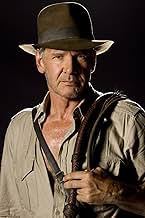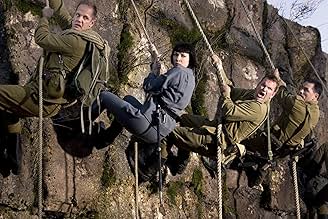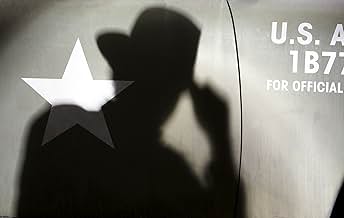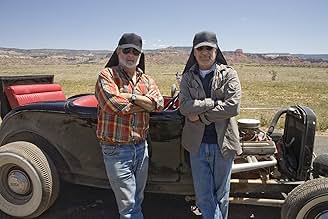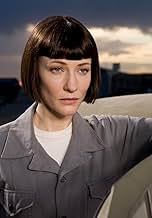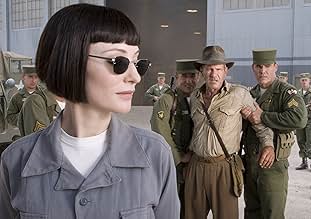Indiana Jones und das Königreich des Kristallschädels
1957 wird der Archäologe und Abenteurer Dr. Henry "Indiana" Jones Jr. (Harrison Ford) wieder in Aktion gerufen und verstrickt sich in einen sowjetischen Komplott, um das Geheimnis hinter mys... Alles lesen1957 wird der Archäologe und Abenteurer Dr. Henry "Indiana" Jones Jr. (Harrison Ford) wieder in Aktion gerufen und verstrickt sich in einen sowjetischen Komplott, um das Geheimnis hinter mysteriösen Artefakten, den sogenannten Kristallschädeln, aufzudecken.1957 wird der Archäologe und Abenteurer Dr. Henry "Indiana" Jones Jr. (Harrison Ford) wieder in Aktion gerufen und verstrickt sich in einen sowjetischen Komplott, um das Geheimnis hinter mysteriösen Artefakten, den sogenannten Kristallschädeln, aufzudecken.
- Nominiert für 1 BAFTA Award
- 10 Gewinne & 42 Nominierungen insgesamt
- Russian Soldier
- (as Veniamin Manzyuk)
- Minister
- (as VJ Foster)
Handlung
WUSSTEST DU SCHON:
- WissenswertesHarrison Ford was adamant that he got to wield Indiana's famous whip. Paramount executives wanted the weapon to be computer generated because of new movie safety rules, but Ford branded the rule "ridiculous".
- PatzerIn Indiana Jones und der letzte Kreuzzug (1989), Henry Jones drank from the cup of Christ, which was reported to give eternal life. In this movie he is said to have died. This is because he passed the seal on the floor where the grail was located. Once you cross the seal, you are no longer immortal.
- Zitate
Indiana Jones: Brutal couple of years, huh, Charlie? First Dad, then Marcus.
Dean Charles Stanforth: We seem to have reached the age where life stops giving us things and starts taking them away.
- Crazy CreditsThe movie begins with the Lucasfilm logo, followed by the 1954 Paramount "VistaVision" logo (with the text "PARAMOUNT" instead of "A PARAMOUNT PICTURE" and "A Viacom Company" instead of "A Gulf+Western Company" below "PARAMOUNT"). Gulf+Western became Paramount Communications in 1989, then merged with Viacom in 1994. The Paramount logo then dissolves into a gopher mound. (The static version of the current Paramount logo is seen at the end of the movie.)
- Alternative VersionenFor those interested in the most arcane aspects of viewing this film, or simply skipped the theatrical and DVD releases, there is a detailed discussion of the differences between the original showing, and the broadcast premier on NBC TV, which may be found on movie-censorship.com. To summarize these differences, they mostly consist of differences in the aspect ratio of the film, a small amount of zooming the screen in order to tone down the most violent scenes, the dubbing in of less offensive language for a couple of 'four-letter' words, and, of course, the usual practice of broadcast television to de-emphasize the end credits in the name of advertising another program.
- SoundtracksHound Dog
Written by Jerry Leiber and Mike Stoller
Performed by Elvis Presley
Courtesy of The RCA Records Label
By arrangement with Sony BMG Music Entertainment
This fourth adventure by the American archaeologist continues to bring good doses of adventure, ingenious scenes and fun to those who follow. In the three Indiana Joness of 1981, 1984 and 1989, the MacGuffins are the treasures: the Ark of the Covenant, the Sankara stones and the Holy Grail, respectively. For the fourth film, Lucas wanted to put ETs in the middle; Ford and Spielberg, not so much. They reached a consensus that it is the translucent skull of Indiana Jones and the Kingdom of the Crystal Skull. David Koepp's script follows the Kingdom of the Crystal Skull structure, which is identical to that of Raiders of the Lost Ark: good guys and bad guys fighting for terrain in a race that will only be solved in the final corner. The difference is that in the new cat and mouse game, the Nazis leave and the Soviets enter the full 1950s.
The script seeks to fill in the gaps left by Connery (who refused to abandon retirement), Elliott (who died in 1992) and John Rhys-Davies (who overcharged) from creating obvious and unimaginative substitutes: the teacher Oxley, which Hurt is forced to interpret distantly, as if in a trance, for almost the entire film; the dean who appears at the head of Jim Broadbent; and the poorly developed assistant experienced by Ray Winstone. Meanwhile, paling in front of the villains of the original films, Cate Blanchett plays the Russian Irina Spalko in an absolutely caricatural way, never sounding threatening and letting her hairstyle, costume and accent do all the work of "composing" the character. On the other hand, it is undeniable that Lucas had a good idea in bringing an impetuous young man as a counterpoint to the aging protagonist, which, in an ideal world, could recapture the wonderful dynamics established by Ford and Connery in "The Last Crusade", oscillating only Indiana's stance towards the frowning side of the spectrum - and, in fact, this effort can be seen in the scene in which Mutt, after a bold move, looks with a proud smile at Indy, who returns a sullen expression (exactly as it had happened so many times in the 89 film). Unfortunately, this dynamic appears only punctually throughout the projection, which prefers to spend more time on the repeated (and only occasionally funny) references to the hero's more advanced age. Likewise, Marion's return is disappointing for not rescuing the explosive chemistry seen in Hunters, since everything here seems just an uninspired imitation of what happened in the original: the couple's fights seem forced, as well as the eventual (and inevitable) romance.
The irregularity of the script, however, is not only characteristic of the development of the characters. Contrary to what happened in the previous films, the Indiana Jones plot and the Kingdom of the Crystal Skull is not only not interesting, it is also developed in a chaotic way. The plot of the crystal skulls is the worst of the entire series, even surpassing the already claudicating of Sankara stones in Indiana Jones and the Temple of Doom: you never know what the skulls really are, what they can do, how they came to be here and why there is a need to return them. The story is so absurd that Spielberg, Koepp and Lucas simply have no idea how to end it, culminating in an ending that comes close to catastrophe.
If before Indy's missions were explained in a simple and objective way, putting the narrative in motion quickly, here the searches and deductions of the heroes take a long time - and the worst: nevertheless, they do not become clearer. Furthermore, although there is an obvious symbolic Catholic aspect in the presence of 13 aliens (Christ and the apostles), the nature of that temple and the objectives of the creatures are never clear. In fact, the fact is that the plot of The Kingdom of the Crystal Skull is simply bad - and Lucas's insistence on using it is probably the biggest factor responsible for the failure of this new film, since not even Indy's motivations are explained satisfactorily: why, for example, does he insist so much on "returning" the skull as Oxley wishes? And why did Ox, after failing in his first effort to enter the temple, return the artifact to the place where he had found it instead of saving it for later attempts? And why do certain creature (s) act that way at Irina's request? Unfortunately, instead of trying to refine the plot, Koepp tries to disguise the absurdities through ridiculous lines like "They went back to the space between the spaces" (in fact, practically everything that John Hurt has to say in this film hurts his ears).
Another thing that bothers is the fact that Spielberg sometimes treats the characters as unbeatable. Some of the best scenes in the entire series are forced and exaggerated, like the mine chase in 'Indiana Jones and the Temple of Doom' or the classic truck moment in 'Raiders of the Lost Ark'. These sequences, however, also worked thanks to the reactions of the characters, who were surprised by the facts. In Indiana Jones and the Kingdom of the Crystal Skull, they seem to be sure they will never be hurt, resulting in moments that are difficult to swallow like the jump of Marion's jeep. There is a limit to common sense. Despite this, the action sequences mostly work. From the start in the car duel in the desert with Soviet soldiers, going through the whole sequence in the warehouse and in the bizarre ghost town (except the refrigerator scene, of course), the motorcycle chase in college, culminating in the forest race, including the falls in the geographically incorrect Iguazu Falls and the revelation of El Dorado, what we see is pure Indiana Jones, albeit with a Steven Spielberg much less inspired by evoking truly unforgettable moments. Again, he exaggerates like the endless sword fight on top of the cars and the dark "Tarzan moment" with Mutt in the vines, but, in general, the director gets it right by materializing Koepp's ideas in a harmonic set.
However, with the exception of a motorcycle chase in the first act, nothing in this project reminds us of brilliant moments like Indy and the Nazi trucks (in Raiders of the Lost Ark), the chase on the underground tracks (in Temple of Perdition) or the tank fight (in The Last Crusade). Yes, there is a long fight over jeeps in the jungle, but the most that Spielberg can create is a beaten mutt gag being hit between the legs by the local vegetation. In addition, the sequence is orchestrated in a confusing, almost chaotic, bordering on laziness when, after the fight comes to an end, new Russian vehicles appear out of nowhere. In the same way, if the joke involving the tree that hits the communist agents hanging from the rock is even funny, it is sad to realize that, soon after, those same henchmen reappear next to Irina, as if nothing had happened. And why does Spielberg insist on showing agile natives hiding in the temple and other ruins if their nature is never explained clearly and they have no effect on the narrative's development?
The production tried to use the maximum of practical and stunt effects to avoid overuse of computer graphics. Despite using many practical effects, a 2008 production could not very easily evade CGI, and here I have it that Spielberg made a premeditated - and ultimately misunderstood - choice to make computer graphics emulate the effects practical that would have been possible, to a certain extent, in the 1980s, bringing an "old-fashioned" veneer to the film which, I am the first to say, sometimes seems strange. Even with all its problems, however, Indiana Jones and the Kingdom of the Crystal Skull works at least as an exercise in nostalgia: it is pleasurable, as a movie buff, to review the Paramount logo turning into a real version that opens the adventure or accompanies the hero's path through the red line on a map. In addition, Spielberg is adept at rescuing all the language of previous films, from the constant travellings that bring us closer to the characters at dramatically relevant moments to the occasional backlight that marks the (here, only supposed) strength of the villains. Likewise, director of photography Janusz Kaminski does an impeccable job in recreating the style of the now retired Douglas Slocombe, recapturing his preference for shadows and silhouettes, for plans that reveal only the characters' eyes and for the elegant sepia tone that gives the film a classic tone that, even beautiful, does not betray the homage to the B productions made by the series. Not to mention another soundtrack by John Williams. How not to shiver with the Indy theme? Revisiting classics and showing that he is still a master at what he does, this trio - Lucas, Spielberg and Ford - proves that the new doesn't always mean the best. In some cases, luckily, the experience still has a lot to say.
- fernandoschiavi
- 27. Juni 2020
- Permalink
Top-Auswahl
'Indiana Jones' Stars Through The Years
'Indiana Jones' Stars Through The Years
Details
- Erscheinungsdatum
- Herkunftsland
- Offizieller Standort
- Sprachen
- Auch bekannt als
- Indiana Jones y el reino de la calavera de cristal
- Drehorte
- Produktionsfirmen
- Weitere beteiligte Unternehmen bei IMDbPro anzeigen
Box Office
- Budget
- 185.000.000 $ (geschätzt)
- Bruttoertrag in den USA und Kanada
- 317.101.119 $
- Eröffnungswochenende in den USA und in Kanada
- 100.137.835 $
- 25. Mai 2008
- Weltweiter Bruttoertrag
- 786.636.033 $
- Laufzeit2 Stunden 2 Minuten
- Farbe
- Sound-Mix
- Seitenverhältnis
- 2.39 : 1







